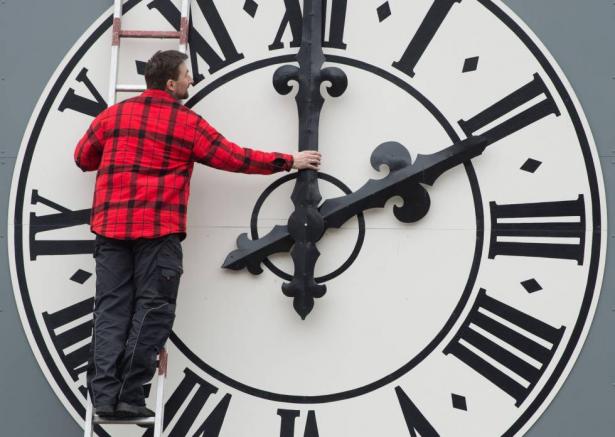The down-to-the-minute scheduling of the entire planet, which began with the modern age of globalization, is a messy miracle: After thousands of years of living on local solar time, it took humans less than 200 to coordinate billions of people down to the second. The effort began in earnest in the 1800s with the advent of the railway systems in the UK, where Greenwich Mean Time was established.
But though time seems universal, a look at time zones around the world shows its anything but. Deciding what time it is where is a complicated, and made more so by the even tradition of daylight savings time. Almost as soon as countries around the world agreed to observe time zones, in 1884, some Canadians started turning their clocks forward in the summer. By 1916, daylight savings was catching on around the world.
Time zones can be as much about politics as logistics. Spain switched time zones in 1941, a gesture of solidarity from Francisco Franco to Adolf Hitler. When Crimea voted to join Russia in 2014, it moved its clocks two hours ahead to join Moscow’s time zone. In 2015, North Korea adopted Pyongyang Time, setting clocks back half an hour to reflect the time before Japanese colonization. More recently, states in the Northeastern US have flirted with ditching daylight savings and moving into a new time zone. India considered adding another. Spain has debated a time-zone shift that would, for better or worse, disrupt a famous way of life.
The tinkering will likely continue to eternity, unless we go all out and create the temporal equivalent of Esperanto.
Essential time zone stats
38: Number of time zones currently in use around the world
17: Number of time zones offset from Coordinated Universal Time by intervals of 30 or 45 minutes
40%: Share of the world’s population that lives in the eight countries operating under their own time zones, instead of Coordinated Universal Time
3.5 hours: The biggest time zone gain/loss (outside the International Date Line), along the 47-mile (76-km) border between Afghanistan and China
15 minutes: Offset between India (UTC +5.5) and Nepal (UTC +5.75)
$59 million: Money saved from decreased robberies by the 2007 daylight savings time extension
What is Greenwich Mean Time?
The adoption of time zones was made easier by establishing a benchmark: Greenwich Mean Time. In the 1670s, British astronomer John Flamsteed was employed at the Royal Observatory in Greenwich Park in London, where he figured out how to convert the apparent solar time (what you would see on a sundial, which results in days of inconsistent length) to mean solar time (which assumes a fictional sun that moves at a uniform rate). His catalog of stars was set to GMT, which became crucially important as the UK became a modern naval power. GMT has since given way to Coordinated Universal Time (UTC), but UTC is basically GMT, and all time zones are relative to the prime meridian in Greenwich, where it all began.
A history of time zones around the world
1840: Britain’s Great Western Railway adopts a standard time at all stations. Seven years later, all British stations start running on Greenwich Mean Time. By 1880, Britain adopted it nationwide.
1883: Many railroads and governments adopt the General Time Convention, which divided the United States and Canada into five time zones.
1884: Twelve nations agree to use GMT as the international basis for time zones at the International Prime Meridian Conference.
1912: The newly created Republic of China adopts five time zones.
1918: President Woodrow Wilson makes four US time zones official with the Standard Time Act.
1947: Newly independent India adopts a single time zone.
1949: The new communist government collapses China’s five time zones into one.
1960: The International Radio Consultative Committee formalizes the concept of UTC, with time synchronized using atomic clocks. (The acronym is a compromise between England and France.)
2011: Samoa skips a Friday in order to switch sides of the International Date Line. Dmitry Medvedev cuts Russia’s time zones from 11 to nine.
2014: Vladimir Putin increases Russia’s time zones from nine to 11.
What time is it in Antarctica?
Antarctica lies on every line of longitude, but time is funny there: Even regions that lie along the same meridian don’t necessarily observe the same time. Time zones are based on territorial claims, but even within that, it gets messy. Stations might use the time of the country that owns them or the time of their supply base. To simplify, some places simply just observe Coordinated Universal Time.
How many time zones do we really need?
- Science writer James Gleick makes the case that time zones are a relic of the industrial age and our networked era demands one world time zone.
- Tim Harford, aka the Undercover Economist, makes the same case–at least for the United States.
- Quartz’s Alison Schrager has a compromise: she’s noticed that America functions on fewer than four time zones, but one time zone would veer too far from solar time. So how does two time zones sound?
- Swiss watchmaker Swatch teamed up with MIT Media Lab founder Nicholas Negroponte to create a single time for the internet—a decimal-based system of 1000 “.beats” per day. It didn’t catch on, but it left enough of a legacy that you can still get on Swatch Internet Time.


Spread the word